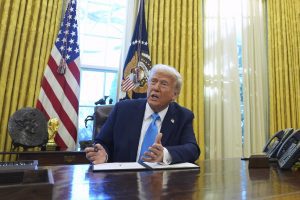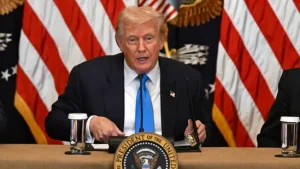Washington D.C. – President Donald Trump signed a comprehensive Trump Executive Order On Reciprocal Tariffs on Thursday evening, imposing import duties ranging from 10% to 41% on goods from multiple countries and territories. This landmark legislation represents the most extensive tariff implementation in recent American history, targeting 68 nations and the 27-member European Union with varying duty rates.
The Trump Executive Order On Reciprocal Tariffs was signed shortly after 7 PM on Thursday, following several days of intense tariff-related negotiations and diplomatic activities. The executive order establishes a new framework for American trade policy that will fundamentally reshape international commercial relationships and challenge existing global economic structures.
Specific Country Tariff Rates Revealed

The Trump Executive Order On Reciprocal Tariffs establishes distinct tariff rates for major trading partners based on their individual trade relationships with the United States. India faces a 25% tariff on all exports to America, while Taiwan will experience a 20% duty rate on its goods entering the US market.
South Africa confronts a substantial 30% tariff under the Trump Executive Order On Reciprocal Tariffs, reflecting the administration’s assessment of trade imbalances and regional economic characteristics. These specific rates demonstrate the targeted nature of Trump’s approach to addressing perceived unfair trading practices.
Seven-Day Implementation Timeline
The Trump Executive Order On Reciprocal Tariffs establishes a seven-day implementation period before the new duties take effect, marking the next phase of Trump’s aggressive trade strategy. This timeline provides minimal adjustment period for affected countries and businesses, emphasizing the administration’s urgency in addressing trade imbalances.
Also Read: Explosive Dead Economies Statement By Trump On India And Russia, Sparks Conflict
International observers expect the Trump Executive Order On Reciprocal Tariffs to significantly challenge the global economy and strain traditional international alliances. The rapid implementation schedule suggests that diplomatic negotiations have failed to achieve the administration’s desired trade concessions.
Comprehensive Global Coverage Strategy


The Trump Executive Order On Reciprocal Tariffs encompasses 68 individual nations plus the entire European Union, creating one of the most comprehensive tariff regimes in modern American history. Countries not specifically named in the order will face a standard 10% tariff rate, ensuring that virtually all international trade partners face some level of increased duties.
Senior administration officials explained that the Trump Executive Order On Reciprocal Tariffs rates were determined based on each country’s trade imbalance with the United States and broader regional economic characteristics. This methodology attempts to create proportional responses to perceived unfair trading practices.
Canada Faces Escalated Fentanyl-Related Penalties
Beyond the standard Trump Executive Order On Reciprocal Tariffs, Trump signed a separate measure specifically targeting Canada with increased duties. Canadian imports will face a 35% tariff rate, elevated from the previous 25% level, effective August 1.
This Canadian escalation, while separate from the Trump Executive Order On Reciprocal Tariffs, reflects Trump’s frustration with Canada’s alleged failure to cooperate in curbing fentanyl flow into the United States. The President accused Canada of retaliating against earlier American tariffs rather than addressing drug trafficking concerns.
Fentanyl Crisis Drives Canadian Policy
The Canadian tariff increase accompanying the Trump Executive Order On Reciprocal Tariffs specifically targets goods linked to fentanyl-related trade activities. Trump’s administration has directly blamed Canada for failing to prevent the ongoing flood of fentanyl and other illicit drugs into American communities.
The White House fact sheet supporting the Trump Executive Order On Reciprocal Tariffs emphasized that Canada had “failed to cooperate” and had “retaliated against the United States” rather than addressing legitimate American concerns about drug trafficking through Canadian territory.
USMCA Agreement Provides Limited Exemptions


Despite the broad scope of the Trump Executive Order On Reciprocal Tariffs, certain Canadian and Mexican goods remain exempt under the US-Mexico-Canada Agreement framework. This exemption reflects successful lobbying efforts by American car manufacturers and other firms with interconnected North American supply chains.
The USMCA exemption within the Trump Executive Order On Reciprocal Tariffs structure demonstrates the administration’s recognition that some trade relationships require special consideration. This carve-out enables US importers to continue receiving most goods from Mexico and Canada without facing the full tariff impact.
Trade Deficit Reduction Objectives


The Trump Executive Order On Reciprocal Tariffs aims to address America’s substantial trade deficits with multiple nations through punitive duty structures. The administration expects these measures to encourage foreign countries to reduce their own tariffs and open their markets to American goods and services.
Bank of Canada estimates indicate that the average tariff on Canadian imports was approximately 5% before the new measures, but the Trump Executive Order On Reciprocal Tariffs and additional Canadian penalties will increase this figure significantly.
Global Economic Impact Projections
International economic analysts expect the Trump Executive Order On Reciprocal Tariffs to create substantial disruptions in global supply chains and trading relationships. The comprehensive nature of the tariff structure affects virtually every major trading partner, potentially triggering retaliatory measures from affected nations.
August Deadline Achievement
The Trump Executive Order On Reciprocal Tariffs represents the culmination of Trump’s self-imposed August 1 deadline for addressing international trade imbalances. The administration had threatened various countries with increased tariffs unless they agreed to more favorable trading arrangements with the United States.
The comprehensive scope of the Trump Executive Order On Reciprocal Tariffs demonstrates Trump’s commitment to reshaping international trade relationships through unilateral American action, regardless of diplomatic consequences or international economic cooperation concerns that may arise from these sweeping policy changes.

